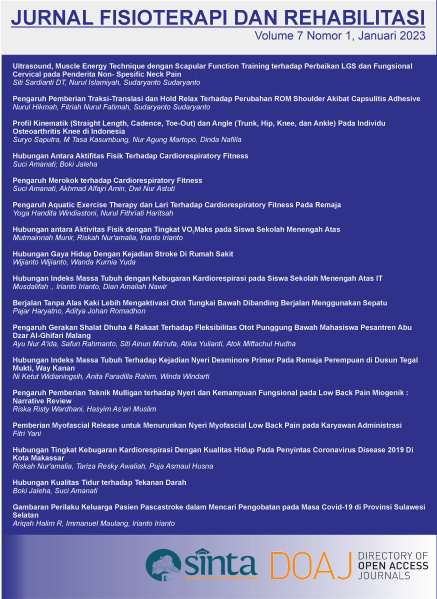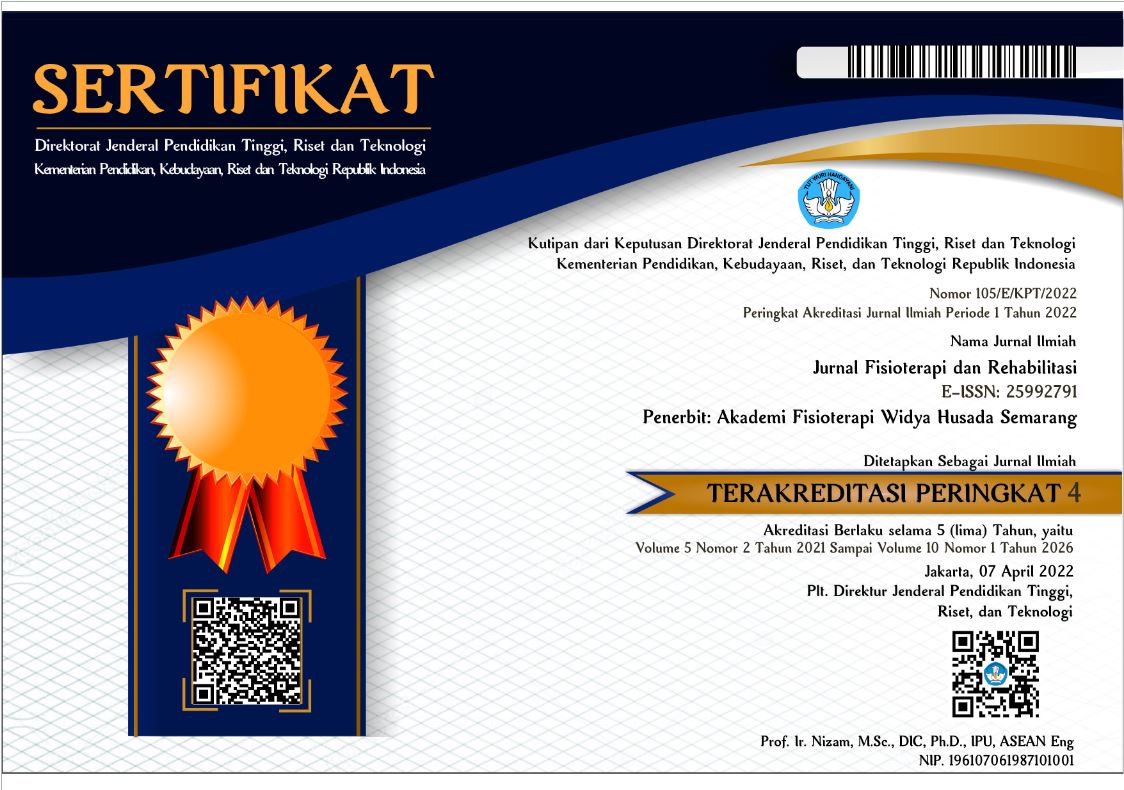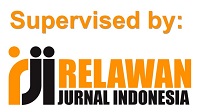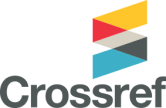Pengaruh Gerakan Shalat Dhuha 4 Rakaat Terhadap Fleksibilitas Otot Punggung Bawah Mahasiswa Pesantren Abu Dzar Al-Ghifari Malang
The Effect Of The 4 Rakaat Dhuha Prayer Movement On The Flexibility Of The Lower Back Muscles Of Abu Dzar Al-Ghifari Islamic Boarding School Malang Students
Abstract
Mahasiswa disibukkan dengan berbagai kegiatan perkuliahan ditambah kebiasaan duduk pada posisi yang salah dan terlalu lama dapat menyebabkan fleksibilitas menurun. Salah satu cara untuk meningkatkan serta mempertahankan fleksibilitas otot punggung bawah adalah dengan gerakan rukuk yang benar dan tepat pada shalat dhuha 4 rakaat. Pada saat gerakan rukuk dilakukan otot tipe I, mengalami kontraksi berulang dan resistensi minimal karena tarikan gravitasi bumi. Penelitian ini mendeskripsikan pengaruh gerakan rukuk pada shalat dhuha 4 rakaat terhadap fleksibilitas otot punggung bawah pada mahasiswa Pesantren Abu Dzar Al-Ghifari Malang. Desain penelitian ini adalah pre-experimental, yaitu One Group Pre-Test and Post-Test Design pada 30 mahasiswa yang mengalami penurunan fleksibilitas dengan alat ukur Sit Up and Reach Test. Berdasarkan hasil uji Paired Sample T Test di dapatkan hasil yang siginifikan yaitu 0,000, dinyatakan bahwa terdapat pengaruh gerakan rukuk pada shalat dhuha 4 rakaat terhadapa fleksibilitas otot punggung bawah responden. Maka disimpulkan gerakan rukuk pada shalat dhuha 4 rakaat selama 15 hari memberikan pengaruh pada fleksibilitas otot punggung bawah mahasiswa Pesantren Abu Dzar Al-Ghifari Malang.
Downloads
References
Alpharesi, N. (2020) ‘Hubungan Fleksibilitas Hamstring Badminton Program Studi S1 Fisioterapi Fakultas Ilmu Kesehatan Universitas ‘ Aisyiyah Yogyakarta Badminton’.
Aqlan, F. et al. (2017) ‘An ergonomic study of body motions during Muslim prayer using digital human modelling’, International Journal of Industrial and Systems Engineering, 25(3). doi: 10.1504/IJISE.2017.081918.
Bafirman, W. and Asep, S. (2019) Pembentukan Kondisi Fisik Bafirman, Ebook.
Kurniawan, E. Y., Kesoema, T. A. and Hendrianingtyas, M. (2019) ‘Pengaruh Latihan Fleksi Dan Ekstensi Lumbal Terhadap Fleksibilitas Lumbal Pada Dewasa Muda’, Diponegoro Medical Journal (Jurnal Kedokteran Diponegoro), 8(1), pp. 161–170.
Mulyani, E. S. and Hunainah, H. (2021) ‘Pembiasaan Shalat Dhuha Untuk Meningkatkan Disiplin Belajar Siswa’, Qathrunâ, 8(1), p. 1. doi: 10.32678/qathruna.v8i1.4782.
Murti, O. S. (2016) ‘Perbedaan Pengaruh Peningkatan Fleksibilitas Back Muscle Dengan Latihan Pnf Stretching Dan Pilates Exercise Pada Wanita’, Fakultas Fisioterapi: Universitas Esa Unggul, pp. 1–18. Available at: https://www.esaunggul.ac.id/perbedaan-pengaruh-peningkatan-fleksibilitas-back-muscle-dengan-latihan-pnf-stretching-dan-pilates-exercise-pada-wanita/.
Najiib, M. M. M. (2016) ‘Hubungan gerakan sujud terhadap fleksibilitas otot para vertebra (The Relationship of Prostrations to the Flexibility of the Vertebrae Muscles)’, pp. 1–6. Available at: http://eprints.ums.ac.id/47838/1/NASKAH PUBLIKASI.pdf.
Prasetyono, E. R. (2015) ‘Pengaruh gerakan sholat terhadap peningkatan fleksibilitas otot punggung bawah naskah publikasi’, Universitas Muhammadiyah Surakarta.
Rahmanto, S. et al. (2020) ‘Pengaruh Gerakan Sholat Terhadap Ketahanan (Endurance) Otot Extensor Punggung Bawah Pada Mahasiswa Fisioterapi Umm’, Physiotherapy Health Science (PhysioHS), 1(2), pp. 7–12. doi: 10.22219/physiohs.v1i2.13885.
Ali, M., Reinardy, F. and H, A. M. A. (2022) ‘Hubungan Gerakan Rukuk saat Sholat dengan Fleksibilitas Hamstring di Masjid Al Barokah Cimahi’, 2(1), pp. 70–77.
Alpharesi, N. (2020) ‘Hubungan Fleksibilitas Hamstring Badminton Program Studi S1 Fisioterapi Fakultas Ilmu Kesehatan Universitas ‘ Aisyiyah Yogyakarta Badminton’.
Aqlan, F. et al. (2017) ‘An ergonomic study of body motions during Muslim prayer using digital human modelling’, International Journal of Industrial and Systems Engineering, 25(3). doi: 10.1504/IJISE.2017.081918.
Bafirman, W. and Asep, S. (2019) Pembentukan Kondisi Fisik Bafirman, Ebook.
Kurniawan, E. Y., Kesoema, T. A. and Hendrianingtyas, M. (2019) ‘Pengaruh Latihan Fleksi Dan Ekstensi Lumbal Terhadap Fleksibilitas Lumbal Pada Dewasa Muda’, Diponegoro Medical Journal (Jurnal Kedokteran Diponegoro), 8(1), pp. 161–170.
Mulyani, E. S. and Hunainah, H. (2021) ‘Pembiasaan Shalat Dhuha Untuk Meningkatkan Disiplin Belajar Siswa’, Qathrunâ, 8(1), p. 1. doi: 10.32678/qathruna.v8i1.4782.
Murti, O. S. (2016) ‘Perbedaan Pengaruh Peningkatan Fleksibilitas Back Muscle Dengan Latihan Pnf Stretching Dan Pilates Exercise Pada Wanita’, Fakultas Fisioterapi: Universitas Esa Unggul, pp. 1–18. Available at: https://www.esaunggul.ac.id/perbedaan-pengaruh-peningkatan-fleksibilitas-back-muscle-dengan-latihan-pnf-stretching-dan-pilates-exercise-pada-wanita/.
Najiib, M. M. M. (2016) ‘Hubungan gerakan sujud terhadap fleksibilitas otot para vertebra (The Relationship of Prostrations to the Flexibility of the Vertebrae Muscles)’, pp. 1–6. Available at: http://eprints.ums.ac.id/47838/1/NASKAH PUBLIKASI.pdf.
Prasetyono, E. R. (2015) ‘Pengaruh gerakan sholat terhadap peningkatan fleksibilitas otot punggung bawah naskah publikasi’, Universitas Muhammadiyah Surakarta.
Rahmanto, S. et al. (2020) ‘Pengaruh Gerakan Sholat Terhadap Ketahanan (Endurance) Otot Extensor Punggung Bawah Pada Mahasiswa Fisioterapi Umm’, Physiotherapy Health Science (PhysioHS), 1(2), pp. 7–12. doi: 10.22219/physiohs.v1i2.13885.
Ridwan, M. (2020) ‘Ijtihad Pada Era Kontemporer (Konteks Pemikiran Islam dalam Fiqih dan Maqashid al-Syariah)’, Jurnal Masohi, 1(2).
Seo, D. Y. et al. (2013) ‘Morning and evening exercise’, Integrative Medicine Research, 2(4). doi: 10.1016/j.imr.2013.10.003.
Wahyono, N. (2017) ‘Hubungan Shalat Dhuha dengan Kecerdasan Emosional Siswa Kelas X di SMA Muhammadiyah 7 Surabaya’, Tadarus: Jurnal Pendidikan islam, Vol 6(2), pp. 1–15.
Wijaya, A. (2013) ‘Perkembangan fleksibilitas persendian pada anak usia 7-12 tahun ditinjau dari jenis kelamin (Studi Kros-Seksional pada Pelajar Sekolah Dasar di Daerah Kabupaten Karanganyar)’. Available at: https://digilib.uns.ac.id/dokumen/detail/30616/Perkembangan-fleksibilitas-persendian-pada-anak-usia-7-12-tahun-ditinjau-dari-jenis-kelamin-Studi-Kros-Seksional-pada-Pelajar-Sekolah-Dasar-di-Daerah-Kabupaten-Karanganyar.

This work is licensed under a Creative Commons Attribution 4.0 International License.
The use of the article will be governed by the Creative Commons Attribution license as currently displayed on Creative Commons Attribution 4.0 International License.
Author’s Warranties
The author warrants that the article is original, written by stated author(s), has not been published before, contains no unlawful statements, does not infringe the rights of others, is subject to copyright that is vested exclusively in the author and free of any third party rights, and that any necessary written permissions to quote from other sources have been obtained by the author(s).
User Rights
JFR's spirit is to disseminate articles published are as free as possible. Under the Creative Commons license, JFR permits users to copy, distribute, display, and perform the work. Users will also need to attribute authors and JFR on distributing works in the journal.
Rights of Authors
Authors retain all their rights to the published works, such as (but not limited to) the following rights;
- Copyright and other proprietary rights relating to the article, such as patent rights,
- The right to use the substance of the article in own future works, including lectures and books,
- The right to reproduce the article for own purposes,
- The right to self-archive the article
Co-Authorship
If the article was jointly prepared by other authors, any authors submitting the manuscript warrants that he/she has been authorized by all co-authors to be agreed on this copyright and license notice (agreement) on their behalf, and agrees to inform his/her co-authors of the terms of this policy. JFR will not be held liable for anything that may arise due to the author(s) internal dispute. JFR will only communicate with the corresponding author.
Miscellaneous
JFR will publish the article (or have it published) in the journal if the article’s editorial process is successfully completed. JFR's editors may modify the article to a style of punctuation, spelling, capitalization, referencing and usage that deems appropriate. The author acknowledges that the article may be published so that it will be publicly accessible and such access will be free of charge for the readers as mentioned in point 3.












